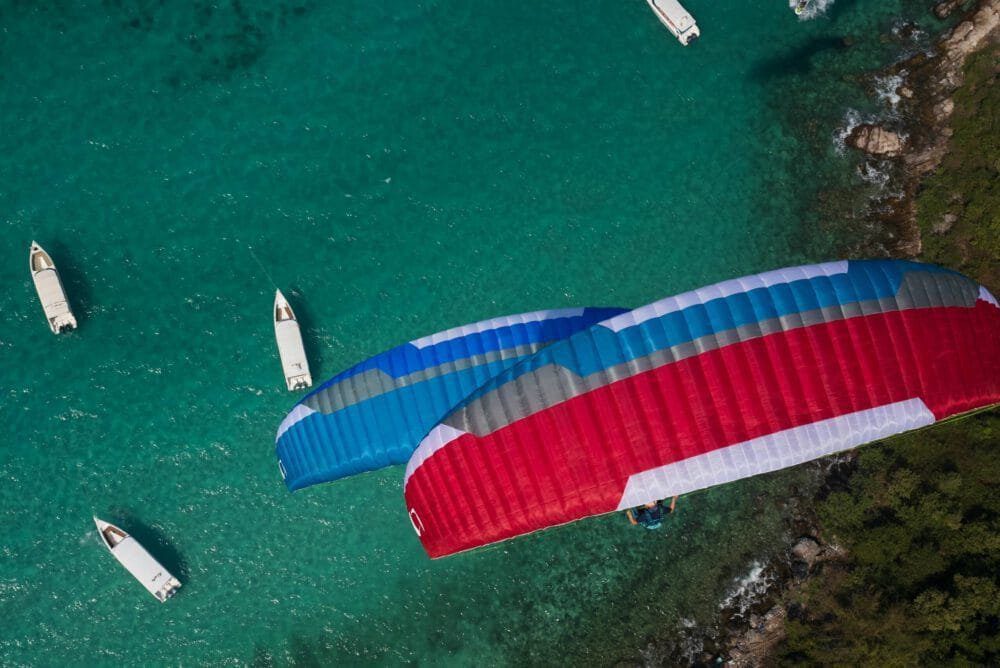
Lightweight Paraglider vs Regular: Which Should You Choose?
First designed for the hike-and-flyers, lightweight paragliders have become increasingly popular in every branch of the sport thanks to the unique benefits they offer pilots.
However, with varying – and contrasting – opinions floating about, you might be finding it difficult to decide if a lightweight paraglider is for you.
With this in mind, we’ve compared lightweight and regular paragliders based on five key differentiators to help you figure out which better fits your needs.
Portability.
Lightweight paragliders are – obviously – lighter, making them easier to carry around, explaining their unrivalled popularity in the ‘hike and fly’ paragliding community.
Lightweight paragliders can also fit into a smaller pack, making them more easily portable on trips; you can even get away with transporting them on planes as hand luggage, making them a great option for those who love to glide abroad.
This is particularly advantageous when we consider that we can’t be sure how our gliders are treated when they’re stored as hold luggage.
Sometimes, airline staff will check bags and pull out their contents without informing the owner, and if they haven’t been careful – or if they simply don’t know how to repack a paraglider or reserve – then they can damage your gear or even render your reserve ineffective if they repack it improperly.
So, for travelling flyers who don’t fancy getting their gear professionally checked after every flight, a lightweight paraglider is a great way to reduce the faff while being comfortable in the knowledge that your gear hasn’t been tampered with.
It also helps to know that the airline company will not misplace your bag interfering with the fling trip you were waiting for.
Durability.
Since there’s no way to tell exactly how long a paraglider will last before succumbing to age or general wear and tear, it’s difficult to quantifiably compare lightweight to regular paragliders.
What we can say, however, is that lightweight paragliders are generally a bit less durable than regular gliders.
Logically, it makes sense that heavier, thicker materials are going to be stronger, and can better handle more rough and ready manoeuvres over an extended period, which is better for pilots who glide accro-style.
Similarly, if you’re a beginner, or if you just tend to do a lot of ground handling for any other reason, then the durability factor is going to make more of a difference to you – especially if you perform this on rough terrain – as lightweight paragliders are more susceptible to wear and tear.
However, for most pilots the durability between a lightweight and regular paraglider is going to be almost negligible.
You may get a hundred more hours out of a regular paraglider than a lightweight one but if you really look after your lightweight glider – and avoid flying into trees – then it should still last the years.
Launch.
Many attest to the fact that lightweight paragliders are a breeze to launch in comparison to their heavier cousins.
Since the wing is lighter, it inflates and is lifted off the ground and into the air more easily, so as you move forward across the ground, it’ll take less time to get you up into the air.
What’s more: guiding the wing into the air as it lifts from the ground will feel more effortless.
Overall, more lightweight paragliders offer an easier launch, allowing pilots to more quickly get off the ground, while making the probability of having to relaunch less likely.
In-flight handling.
As there’s less inertia when you pilot a lightweight glider – often resulting in less extreme shooting – many prefer the handling of a lightweight paraglider.
However, other pilots attest to not being able to tell the difference between the handling of lightweight versus regular once they’re up in the air (though most notice a clear difference at launch).
So, though the weight likely plays at least a small role in the handling of your paraglider, we can assume that the brand and specific glider you opt for are also going to influence whether you notice a difference in-flight of the handling of your paraglider. IE light wings have the tendency to transmit more the effect of the air. So not every pilots like this.
Cost.
Lightweight – yet still robust – paragliders are typically more expensive than regular paragliders due to the increased cost of the materials used.
There’s not a whole lot more to say about this: if you’d prefer to spend less, then you might be better off going for a regular paraglider, rather than opting for the cheapest lightweight paraglider available, potentially sacrificing durability as a result.
In conclusion…
Whether you opt for a lightweight or regular paraglider depends on your preferences and proclivities as a pilot.
If you’re often performing extreme manoeuvres in the air – whether intentionally or not – or your
flying habits, or status as a beginner, means you’re doing a lot of ground handling on rough terrain, then opting for a lightweight paraglider might not be the best idea.
In addition to being more vulnerable to wear and tear that could endanger you, the frequency at which you may have to replace your lightweight paraglider isn’t going to be worth the cost.
However, for most other flyers, who engage in XC flying, Hike and fly, calmer – or at least, less acrobatic – flying, and try to avoid ground handling too much on rough terrain, the lightweight paraglider can offer a more effortless launching and flying experience, while enabling adventurous pilots to more easily go wherever the wind takes them, with their lightweight gliding gear in tow.






